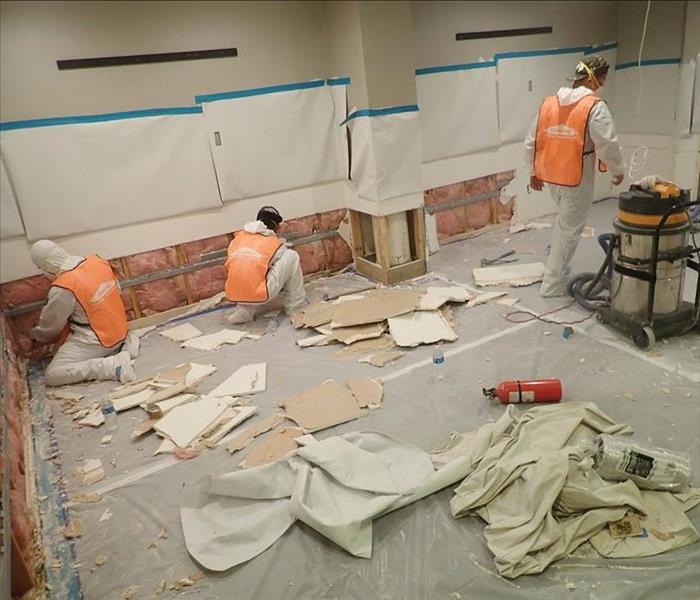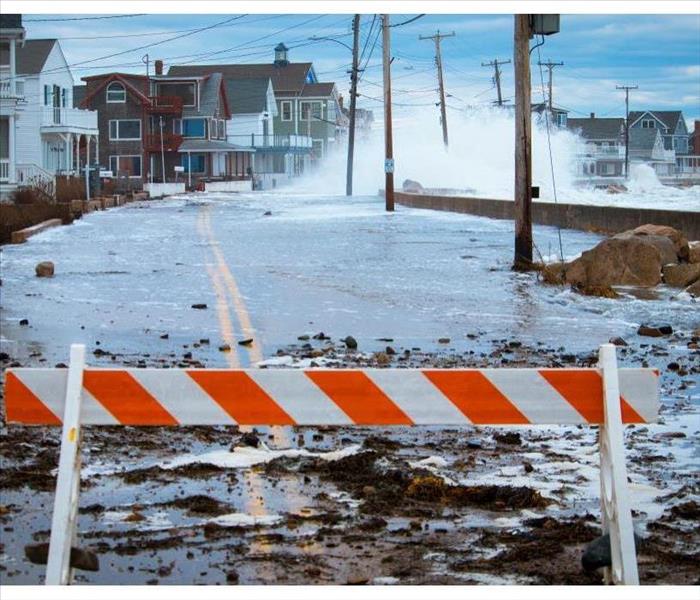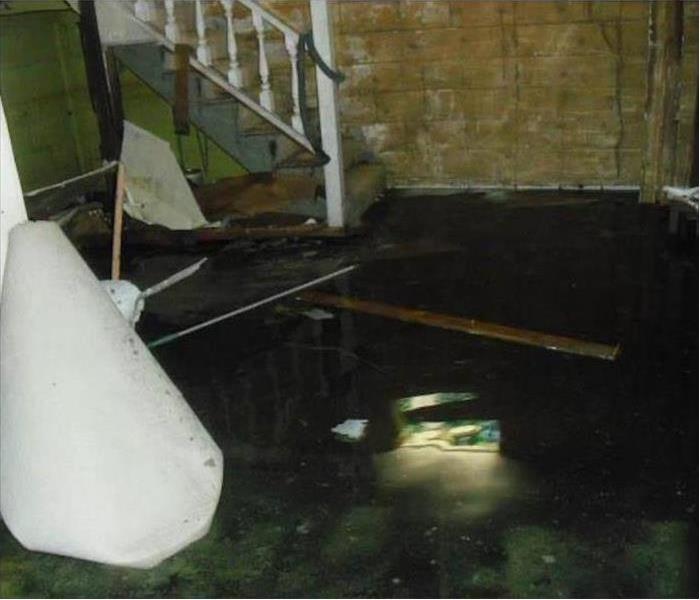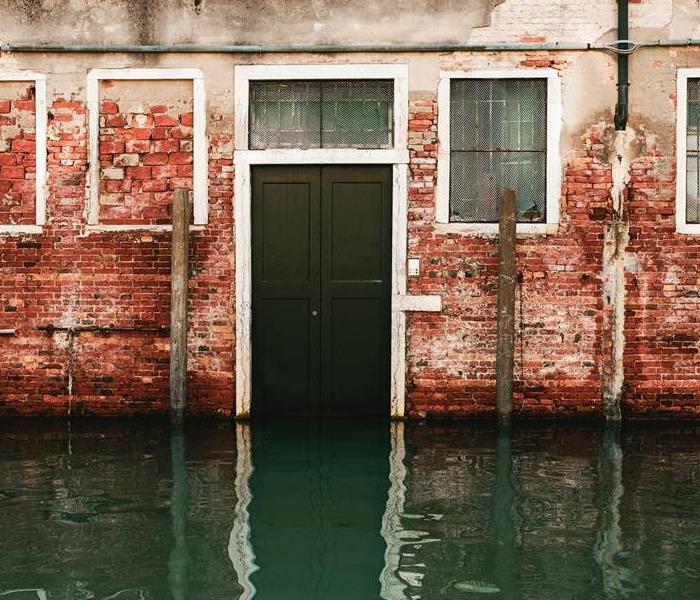Archived Storm Damage Blog Posts
How To Prepare Your Office for a Severe Storm
5/24/2021 (Permalink)
 Flood damage to a building in Fountain Valley, CA.
Flood damage to a building in Fountain Valley, CA.
Prepare For Severe Weather At Work
Thunderstorms threaten both residential homes and commercial business buildings every year. Severe storms can produce high winds, hail, and lightning, all of which can wreak havoc on structures and cause harm to their occupants. If you are a building manager looking to equip your business with the proper safety features to withstand a thunderstorm, read below to learn how to best prepare for severe weather at work.
Plan in Advance
A severe rainstorm can appear seemingly out of nowhere. Therefore, be sure your office is ready for an emergency by organizing proper first aid equipment if or when it is needed. Conventional emergency kits often include:
- Water
- Batteries
- Nonperishable food
- Blankets
- First-aid supplies
- Medicine
Additionally, ensure your office has an evacuation plan in place, and conduct practice storm drills regularly. Don't forget to post relevant contact numbers near the first aid supplies in the event an employee needs to place an emergency call.
Take Proper Emergency Precautions
If a severe rainstorm in Fountain Valley, CA, is imminent, ensure you and your employees follow proper office protocol. Track local news channels, and listen for forecasts and updates regarding the storm's severity.
Encourage employees to remain inside by canceling any planned outdoor functions or gatherings. Further, recommend they steer clear of the windows as they can potentially shatter in the high winds of a violent thunderstorm.
Finally, in anticipation of a power outage, charge all mobile devices and tablets so that they will be usable during the storm.
Recover Appropriately
Even when a rainstorm subsides, you must continue to take proper precautions to ensure employee safety. First, steer clear of any storm-damaged structures until professionals conduct a storm damage assessment. Continue listening to local news coverage, which will indicate road closures, traffic jams, and flooded streets. Lastly, always avoid fallen power lines, and report them to the fire department immediately.
An extreme thunderstorm can present many dangers to an office environment. Proper preparation and awareness can keep your employees safe and out of harm's way.
Different Techniques To Prevent Flooding Throughout History
3/25/2021 (Permalink)
 The Thames Barrier in England
The Thames Barrier in England
Throughout history, different cultures have faced the threat of high water. This often comes in the form of excessive rains that cause rivers and streams to rise, flowing over banks and inundating homes and buildings. Efforts to escape the devastation caused by floods include moving to new areas, building trenches to divert water and piling up sandbags. It is hard to pinpoint exactly when sandbags first were used to stop flooding, but the practice has been around for more than a century. They are inexpensive and effective, though they require a lot of heavy labor.
The Use of Engineering in Flood Prevention
Many places in the world undertook more extensive measures to control flooding. These efforts involved advanced engineering, often on an epic scale. Many of these programs were developed to keep ocean waters from destroying cities or farmland:
- The Thames Barrier in England
- The Watergates of Japan
- The Maeslant Storm Barrier in the Netherlands
- The MOSE Project in Venice, Italy
While effective in stopping high water, these projects were extremely expensive. However, they allowed areas of valuable land to remain in use despite fluctuating water levels.
The Utilization of Restoration Services
In recent times, water cleanups have become increasingly sophisticated thanks to professional storm restoration services for commercial properties. A local franchise in Fountain Valley, CA, employs highly-skilled workers who understand the best techniques for restoring a building. These technicians use advanced equipment such as wet vacuums, industrial fans and thermal imaging cameras to erase the impacts of floods and devastating storms. They also employ a variety of cleaning techniques to clean surfaces of microbial and chemical substances as a result of high water. Since water can destroy and corrode everything from wood to metals, the technicians restore and rebuild areas of a building that have undergone severe damage. While water is indispensable to life on the planet, history has shown that it also requires exceptional efforts when it rages out of control.
4 Things You Should Know About Nor'easters
3/22/2021 (Permalink)
 Nor'easters occur from September to April.
Nor'easters occur from September to April.
4 Things You Should Know About Nor'easters
One of the most confusing nor'easter facts involves the word itself. While it might seem safe to assume that the term nor'easter specifies the geographic area in which the storms are known to occur, it actually refers to the direction from which storm causing winds originate. Cold air currents that move southwest across the cold Northeastern United States are likely to come into contact with warm air moving in the opposite direction. This creates ideal conditions for one of the most infamous storm patterns in the country.
1. Most Storms Happen During Colder Months
The most common times for a nor'easter to occur are from September to April, as these are when the cold air necessary to create one is most abundant. Although they often result in significant snowfall, these storms can also cause heavy rain and strong winds that can be equally damaging.
2. They Can Put a Halt on Your Plans
Major Northeast storm systems can wreak havoc on your work and travel plans. Flooding, heavy snow and downed power lines can all shut down entire metropolitan areas, leaving you with little more than the food and supplies you have stored in your home.
3. They Are Caused by Two Types of Air Movements
Pressure systems that cause trouble in the Northeast can come from the Midwest or Gulf Coast. As these come into contact with the Appalachian Mountains or the East Coast, respectively, they reach their peak levels of precipitation
4. Some of Them Are Famous
Some storms have become to be known to posterity for their economic impact or physical damage. The Blizzard of 1996, for example, dumped 30 inches of snow on Philadelphia in around 24 hours, causing a state of emergency.
If your Beach Boulevard, CA home has suffered damage at the hands of a nor'easter, you should contact a storm restoration specialist who can assess and remedy damage before more harsh weather hits.
Does Your Home Face a High Risk of Flooding?
3/22/2021 (Permalink)
 Flood damage in a Fountain Valley, CA home
Flood damage in a Fountain Valley, CA home
Flooding is an event that many homeowners face. Most homes in Fountain Valley, CA, whether they are in a low or high-risk flood zone, are more likely to experience flooding than fire. Whether you are purchasing a new home or have lived in your current one for a while, you must know if you live in a high-risk flood zone. You must also understand that while most home insurance policies do not cover damage from flooding or storm restoration services, you may be able to purchase flood insurance. If you are in a high-risk zone that participates in the FEMA NFIP, flood insurance may even be required. Therefore, you need to know your home's flood risk and steps you can take to protect yourself.
What Determines a Home’s Risk of Flooding?
The first step to understanding how your home's flood risk is calculated, you want to look at the area's flood maps. These shows important data including:
- Flood zones
- Flood plain boundaries
- Base flood elevation
All of these elements factor into a home's flood risk. These maps can often be found online, at your local government offices, courthouse, or library. You may also want to ask your local government officials if a flood risk project is underway. These projects are designed to identify high-risk areas and lower their chances of flooding. This may also be the perfect time to ask if your community participates in the FEMA NFIP and if you are required to have flood insurance.
Will You Be Told if You Move Into a High-Risk Home?
It is a good idea to conduct this research if you are moving into a new home because not all states require a seller to disclose a property's flood risk. Because of this, it is better if you research your flood risk and if your community participates in the FEMA NFIP.
By doing some research about the area where your home is, you can better understand what determine's your property's flood risk. This can give you an advantage when you are trying to protect yourself from flooding damage.
Storm Damage Property Restoration
11/9/2020 (Permalink)
 Storm floods can be devastating
Storm floods can be devastating
Storms can bring in heavy floods and cause water damage to your home. It’s important to keep in mind that you shouldn’t immediately enter the premises of your property after a storm flood. This is because there might be faulty electrical wirings and the structure of the property might not be as sturdy as before. Moreover, the flood water might have brought sewage wastes. The best and safest thing for you to do is to have your property inspected first.
The best course of action is to have a cleaning and restoration company to inspect your property first. SERVPRO of Fountain Valley is always here to help clean and restore your residential or commercial property after a storm damage. For immediate service, call us at (714) 965-4500 and we will be there as soon as possible.



 24/7 Emergency Service
24/7 Emergency Service




